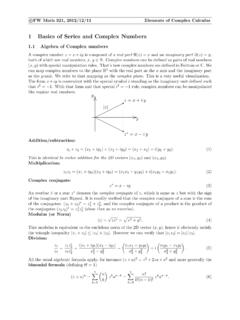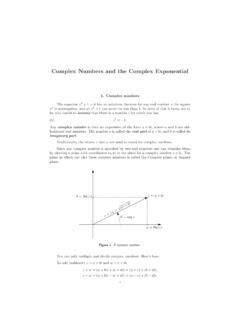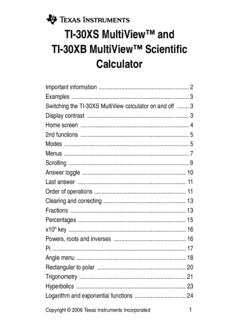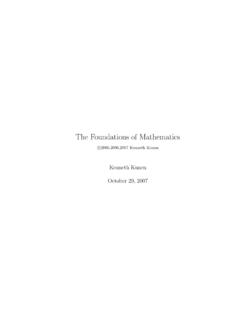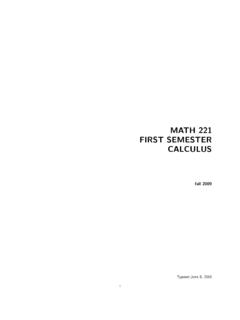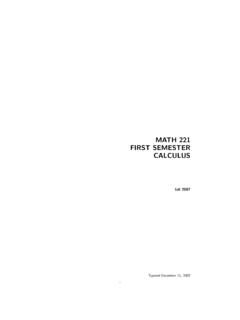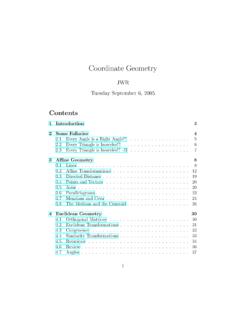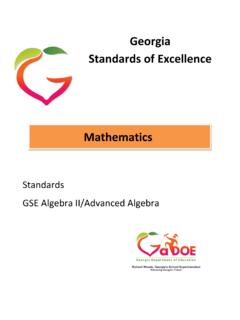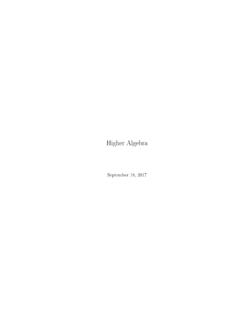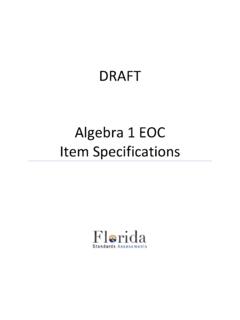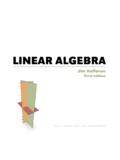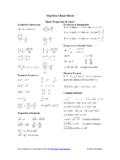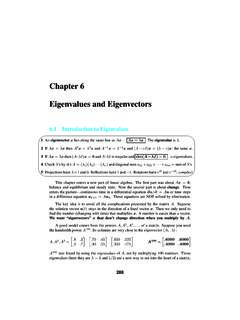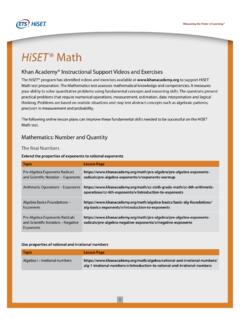Transcription of College Algebra - Department of Mathematics
1 College AlgebraVersion 3 = Stitz, Zeager, Community College Lorain County Community CollegeModified byJoel Robbin and Mike SchroederUniversity of Wisconsin, MadisonJune 29, 2010 Table of ContentsPrefacev0 Basic The Laws of Algebra .. Kinds of Numbers .. Exponents .. Absolute Value .. Solving Equations .. Exercises .. Answers .. 141 The Cartesian Coordinate Plane .. in the Plane .. Relations .. Graphs of Equations .. Three Interesting Curves .. 692 Introduction to Functions.
2 83ivTable of .. Function Notation .. Function Arithmetic .. Graphs of Functions .. Function Behavior .. Transformations .. 1513 Linear and Quadratic Linear Functions .. Defining Functions (Word Problems) .. Quadratic Functions .. Inequalities .. 2124 Polynomial Graphs of Polynomials .. The Factor Theorem and The Remainder Theorem .. 2455 Rational Introduction to Rational Functions .. Graphs of Rational Functions .. 276 Table of .. Rational Inequalities and Applications.
3 2936 Further Topics in Function Composition .. Inverse Functions .. 3297 Exponential and Logarithmic Introduction to Exponential and Logarithmic Functions .. Properties of Logarithms .. Exponential Equations and Inequalities .. Logarithmic Equations and Inequalities .. Applications of Exponential and Logarithmic Functions .. of Exponential Functions .. of Logarithms .. 3978 Systems of Systems of Linear Equations: Gaussian Elimination .. Systems of Linear Equations: Augmented Matrices* .. Determinants and Cramer s Rule*.
4 And Properties of the Determinant .. s Rule .. 437viTable of .. Systems of Non-Linear Equations and Inequalities .. 4519 Sequences and Sequences .. Series and Summation Notation .. IRAs and Mortgages .. Infinite sums and Repeating Decimals* .. 47610 Complex Numbers and the Fundamental Theorem of Complex Numbers .. The Fundamental Theorem of Algebra .. Exercises .. Answers .. 488A The Laws of Algebra The Laws of Algebra .. The Analogy between Addition and Multiplication .. Consequences of the Distributive Law.
5 496 PrefaceThis book is a modified version of the Open Source Precalculus Project initiated by Carl Stitz andJeff Seager. The original version is available indicated on that website you may go order a low-cost, royalty free printed version of the book from Neither author receivesroyalties from , and, in most cases, it is far cheaper to purchase the printed version fromlulu than to print out the entire book at version you are viewing was modified by Joel Robbin and Mike Schroeder for use inMath 112 at the University of Wisconsin Madison. A companion workbook for the course is beingpublished by Kendall Hunt Publishing Co.
6 4050 Westmark Drive, Dubuque, IA 52002. Neither JoelRobbin nor Mike Schroeder nor anyone else at the University of Wisconsin receives any royaltiesfrom sales of the workbook to UW original version of this book contains the following acknowledgements:The authors are indebted to the many people who support this project. From Lake-land Community College , we wish to thank the following people: Bill Previts, whonot only class tested the book but added an extraordinary amount of exercises to it;Rich Basich and Ivana Gorgievska, who class tested and promoted the book; Don An-than and Ken White, who designed the electric circuit applications used in the text;Gwen Sevits, Assistant Bookstore Manager, for her patience and her efforts to get thebook to the students in an efficient and economical fashion.
7 Jessica Novak, Marketingand Communication Specialist, for her efforts to promote the book; Corrie Bergeron,Instructional Designer, for his enthusiasm and support of the text and accompanyingYouTube videos; Dr. Fred Law, Provost, and the Board of Trustees of Lakeland Com-munity College for their strong support and deep commitment to the project. FromLorain County Community College , we wish to thank: Irina Lomonosov for class testingthe book and generating accompanying PowerPoint slides; Jorge Gerszonowicz, KathrynArocho, Heather Bubnick, and Florin Muscutariu for their unwavering support of theproject; Drs.
8 Wendy Marley and Marcia Ballinger, Lorain CCC, for the Lorain CCCviiviiiTable of Contentsenrollment data used in the text. We would also like to extend a special thanks toChancellor Eric Fingerhut and the Ohio Board of Regents for their support and promo-tion of the project. Last, but certainly not least, we wish to thank Dimitri Moonen, ourdear friend from across the Atlantic, who took the time each week to e-mail us typosand other 0 Basic The Laws of AlgebraTerminology and this section we review the notations used in Algebra . Someare peculiar to this book.
9 For example the notationA:=Bindicates that the equality holdsby definitionof the notations involved. Two other notations which will become important whenwe solve equations are = and . The notationP= Qmeans IfP, thenQ . For example,x= 2 = x2= 4. (Note however that the converse statementx2= 4 = x= 2 is not always true since it might be thatx= 2.) The notationP QmeansP= QandQ= P, Pif and only ifQ . For example 3x 6 = 0 x= notations = and are explained more carefully in Section Mathematics the absence of an operation symbol usually indicatesmultiplication:abmeana b.
10 Sometimes a dot is used to indicate multiplication and in computerlanguages an asterisk is often :=a b:=a b:=a bOrder of are used to indicate the order of doing the operations: inevaluating an expression with parentheses the innermost matching pairs are evaluated first as in((1 + 2)2+ 5)2= (32+ 5)2= (9 + 5)2= 142= are conventions which allow us not to write the parentheses. For example, multiplication isdone before additionab+cmeans (ab) +cand nota(b+c),and powers are done before multiplication:ab2cmeansa(b2)cand not (ab) the absence of other rules and parentheses, the left most operations are done b cmeans (a b) cand nota (b c).
